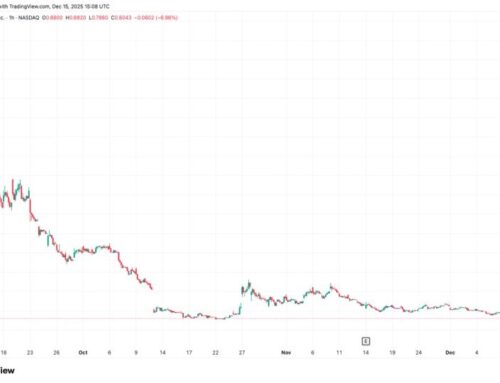Bitcoin Knots gain ground: Will a chain split kill BTC price?
June 21, 2025
A massive surge in Bitcoin Knots nodes hints at a brewing civil war in Bitcoin. If tensions escalate, the price could be the first casualty.

Analysis
Bitcoin Knots, first released by developer Luke Dashjr in the early 2010s, has long offered a more configurable and policy-agnostic alternative to Core.
Currently, most nodes use the Bitcoin Core client to support the Bitcoin network. However, Bitcoin Knots has grown an impressive 638% since the start of the year, jumping from only 394 nodes to 2,909 nodes as of June 19. This massive growth rate started to see significant upticks in May and now makes up 13.24% of all the nodes supporting the Bitcoin network.
Bitcoin Knots’ recent popularity spike suggests that a non-trivial share of Bitcoin’s infrastructure operators no longer trust Core to define Bitcoin’s limits unilaterally.
This is not just technical dissent, it is ideological.
The last time node counts shifted this dramatically was in 2017, on the eve of the SegWit2x showdown. Back then, disagreements over block size and miner power fractured the network into Bitcoin and Bitcoin Cash.
Now, another schism may be forming. Instead of block sizes, it’s about the soul of the protocol, and it may dramatically impact price stability and adoption by year’s end.
Did Bitcoin Knots go from fringe to vanguard?
Bitcoin Knots began as a power-user fork of Core, integrating patches, features and policy tweaks that were too controversial or too early for mainline adoption. It hovered between 50 and 200 active nodes for most of its existence, serving as a staging ground for conservative developers wary of Core’s influence.
From March 2016 through early 2022, node counts barely breached 200. Even during the Ordinals surge in 2023, when BRC-20 tokens and Bitcoin-based inscriptions strained blockspace and sparked renewed debate over what Bitcoin is for, Knots only briefly crested above 1,000 nodes before dropping back.
Then came late 2024. As murmurs of an OP_RETURN cleanup in Core began to circulate, couched in language about pruning, feed efficiency and mempool hygiene, Knots adoption began to climb. By early 2025, it had tripled. By June 19, 2025, it stood at 2,909, with growth still accelerating.
Related: Rushing OP_CAT on Bitcoin could come at an immense security cost
The message behind the numbers is evident. A meaningful subset of Bitcoin’s most technical participants rejects Core’s moral authority. Where it was once assumed that Bitcoin Core spoke for Bitcoin itself, there is a growing appetite for pluralism and perhaps even open defiance.
Bitcoin schism in October 2025?
Tensions escalated further on June 6, when Bitcoin Core developers published a statement signaling a shift toward a “minimally permissive” relay policy. The announcement avoided specific terms such as OP_RETURN or Ordinals, but its implications were clear. Under the new posture, Core clients may soon stop relaying non-standard transactions by default, even if those transactions are valid under Bitcoin’s consensus rules. Critics argue that this policy risks undermining Bitcoin’s neutrality by enforcing a subjective vision of what types of activity should be allowed on the network.
Core’s proposed changes, slated for October 2025, include more restrictive handling of OP_RETURN, the opcode that enables arbitrary data to be embedded in Bitcoin transactions. While this opcode has historically been capped at 80 bytes and discouraged in practice, it has underpinned everything from token issuance via Omni and Counterparty to NFT-style Ordinals in recent years.
Some developers argue that these transactions bloat the chain, crowd out financial activity and should be deprioritized. Others say that selectively disabling or penalizing them violates Bitcoin’s principle of neutrality. If a transaction is valid by consensus rules and pays a competitive fee, it should be relayed and mined.
Knots, notably, do not implement these policy-level filters unless explicitly configured. Its rise suggests that the non-neutrality narrative around Core is gaining traction. In other words, Bitcoin’s policy layer, which was once quietly dictated by a small circle of Core maintainers, is now being contested by nodes switching over to Knots in record numbers.
Related: Bitcoin update to raise data limit on divisive OP_RETURN function
This is not yet a hard fork scenario, but it is inching closer. The 2017 SegWit upgrade reached a boiling point when divergent software choices became incompatible. If Core’s upcoming changes cause blocks or transactions to be rejected by non-Core clients, the stage is set for history to repeat.
And with more than 13% of the network already running Knots, this is not just a protest vote but the beginning of a parallel consensus.
Price may be impacted if history repeats or rhymes
When Bitcoin split into Bitcoin and Bitcoin Cash on Aug. 1, 2017, markets responded with volatility but no collapse.
As Cointelegraph reported, Bitcoin (BTC) dropped approximately 5.6%, falling from about $2,875 on July 31 to $2,718 on the fork day.
However, this dip proved short-lived. Throughout August, BTC surged nearly 49%, closing strong at around $4,050, and continued its meteoric rise to almost $20,000 by December 2017. Meanwhile, Bitcoin Cash (BCH) launched trading at approximately 0.0045 BTC (~$240) and skyrocketed to 0.283 BTC (~$1,500) before stabilizing in the $300-$500 range.
Far from fracturing investor confidence, the fork solidified BTC’s dominance and gave dissenters an alternative in BCH.
The stakes, this time, are higher. With Bitcoin ETFs, corporations’ stacking Bitcoin on their balance sheets and the market being potentially poised for blow-off tops in the foreseeable future, this schism could have more market risk than we have seen in the past.
If Bitcoin Knots keeps its average growth run rate from May through October 2025, there will be over 5,000 nodes running the Knots client. That will equate to around 23% of the entire Bitcoin network.
That level of adoption would mark the largest divergence from Bitcoin Core since the 2017 hard fork, and this time, the rebellion is already inside the house.
Magazine: New York’s PubKey Bitcoin bar will orange-pill Washington DC next
Search
RECENT PRESS RELEASES
Related Post



